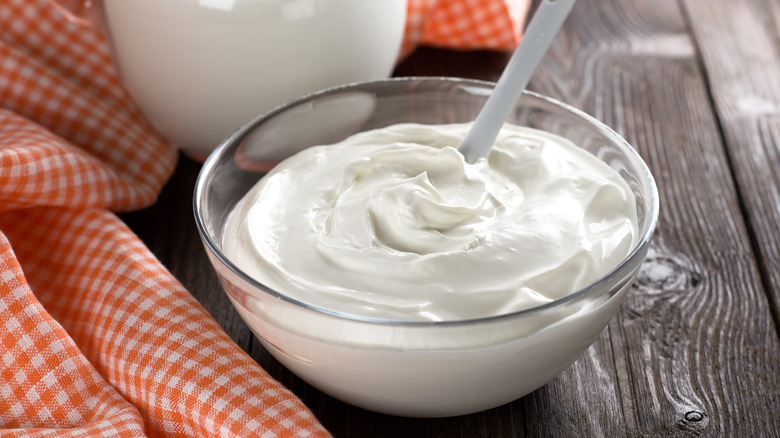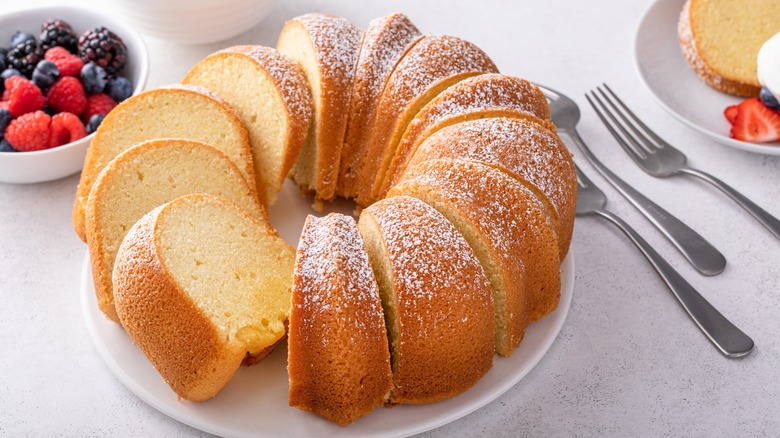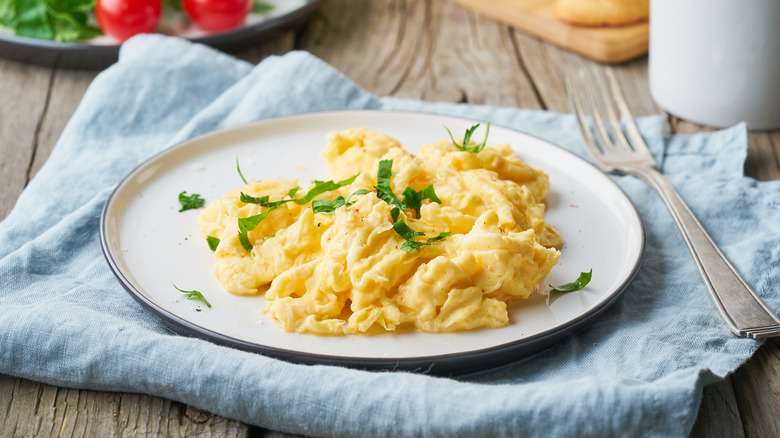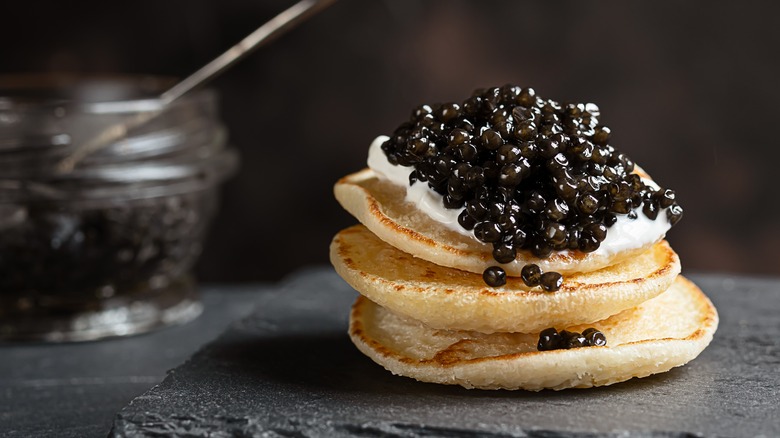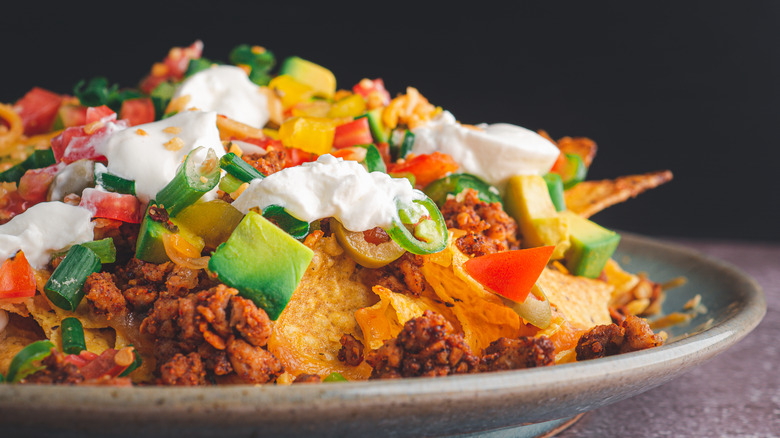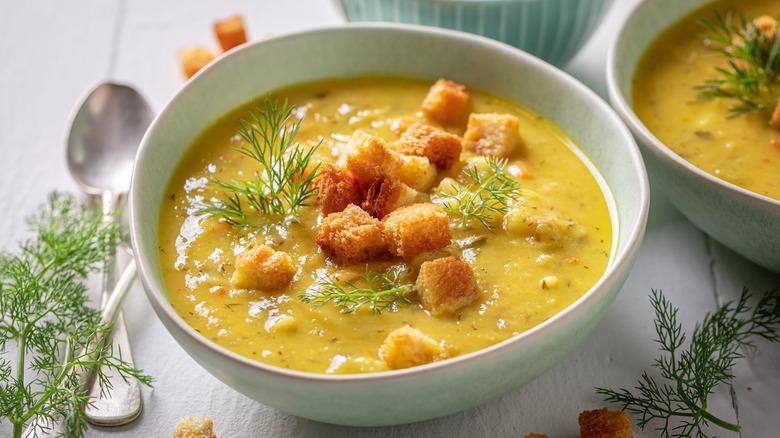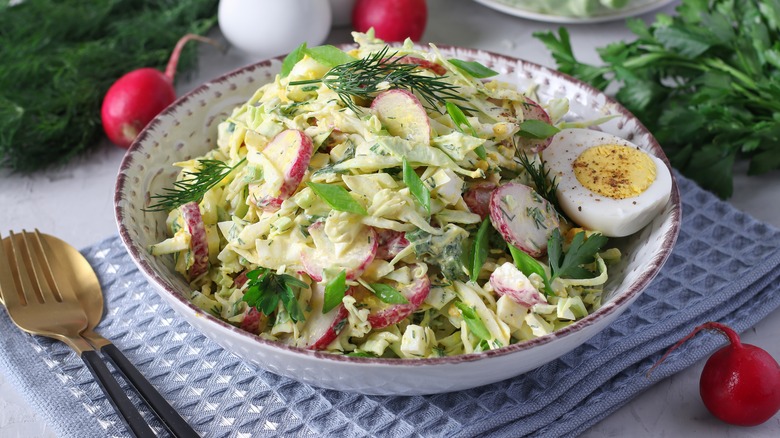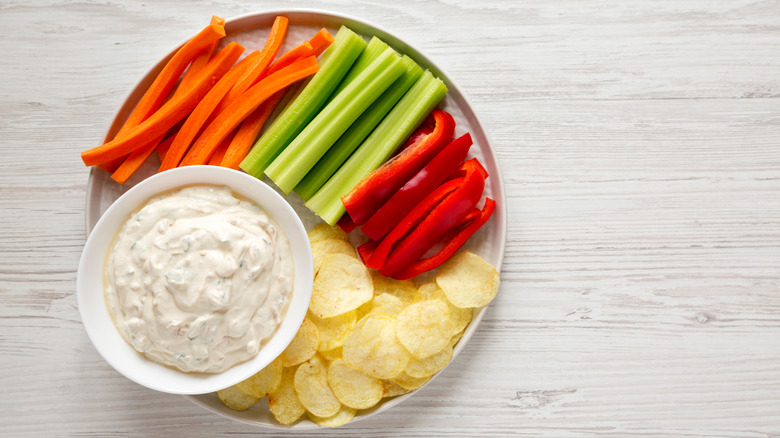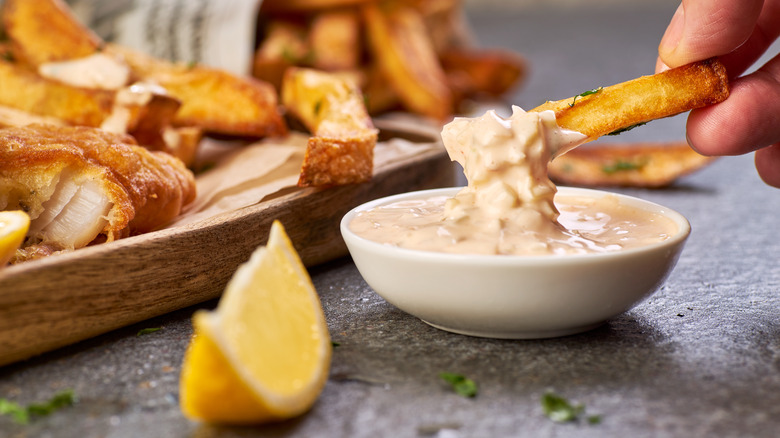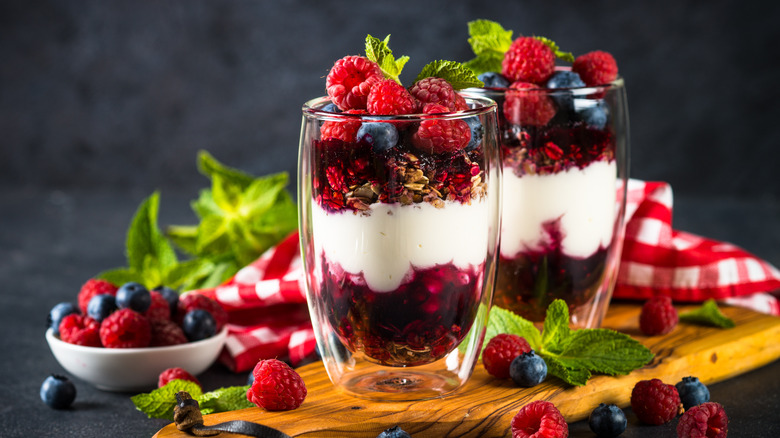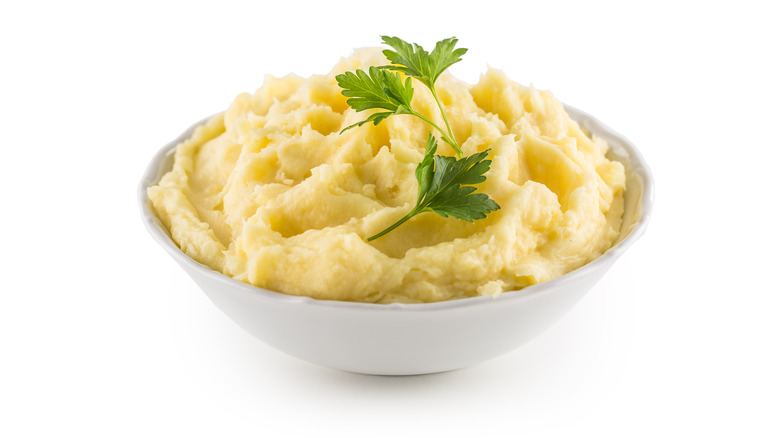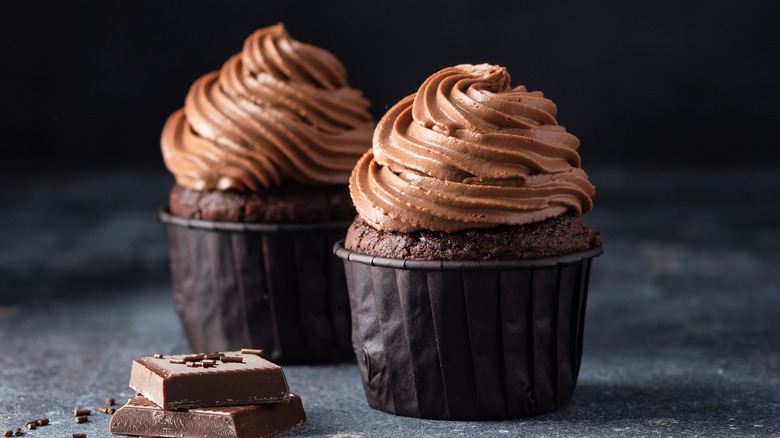13 Sour Cream Uses You Need To Master
We may receive a commission on purchases made from links.
Whether it's a dollop on top or lurking in the background of a recipe, sour cream is a versatile ingredient that should be a staple in your refrigerator. Rather ironically, a light touch of sour cream can be helpful in elevating sweet baked goods. It also adds a cool, calming balance to high-temperature dishes from piping hot baked potatoes to 5-alarm chili.
Since there are only four ingredients that go into homemade sour cream — heavy cream, whole milk, lemon juice, and salt — we would highly advise attempting to make it yourself. To extend the shelf life of sour cream we recommend storing the tub upside down. By doing so, you reduce its exposure to air and bacteria within your fridge and delay any spoilage if it goes uneaten. Store-bought keeps for up to three weeks in the fridge according to the USDA. With homemade, acidified sour cream, exercise a bit more caution and try to use it within a week.
Cultures around the world have embraced the versatility of sour cream and you'll find regional variations on it almost everywhere you go. So whether you're Team Knudsen or you prefer a "dollop of Daisy," here are our favorite uses for sour cream that you should master.
1. Make cakes more moist
If you're gearing up to make a cake, there's no question that fat and sugar are the name of the game. It's a sweet treat, so the sugar component is important. But fat plays a huge role in making the cake spongy.
Enter sour cream. One cup of the stuff contains a jaw-dropping 44.5 grams of fat (via LiveStrong). But while your jaw is dropped, feed it some of the delicious cake that results from adding a spoonful to your batter. It will ensure that you avoid a crumbly disaster and a waste of your time and efforts. We would recommend steering clear of low-fat sour cream because that's not going to add as much help. Go big or go home.
And as for the tangy notes in sour cream, have no concerns. Rest assured those flavors disappear during the bake, the dessert remains sweet as ever, and no one will be the wiser. A humble sour cream pound cake recipe is a great gateway to the wonders of using sour cream in baked goods.
2. Make scrambled eggs fluffier
If you prefer your scrambled eggs to be airy and fluffy (though some do prefer dried-out diner style and we're not judging), adding dairy to scrambled eggs yields incredible results. And you'll get the most bang for your buck when you use products with higher fat content. At 18% fat, sour cream is clearly a better bet than whole milk which maxes out at 3.25% (via the USDA).
You can add sour cream prior to cooking, mixing it in with the raw egg scramble before putting it in the skillet. But a tip from MasterClass recommends adding dairy towards the end of cooking when the eggs are just about done. Either way, just make sure that the heat isn't too high to avoid curdling.
Though adding sour cream contributes to a lighter texture, there's no need to go overboard. A teaspoon per egg should suffice. You definitely want to avoid a situation where the sour cream flavor is dominant over the eggs.
3. Pair it with caviar
While sour cream is used in many humble recipes, it can also appear in one of the most expensive bites of food you'll ever eat. Caviar, the decadent roe of the sturgeon fish, is definitely not cheap and very much special-occasion fare. While caviar can be eaten alone, if you're looking for a partner for this delicacy, look no further than sour cream. Its tang and gentle sweetness are the perfect pairings with the briny oceanic flavor present in caviar. While sour cream is a trusty supporting player, only a dollop is necessary so that the caviar is the star.
Caviar and sour cream, of course, are an iconic duo atop blinis, the passed appetizer that vanishes the minute it emerges at a festive gathering. You can find blini pancakes at the store (particularly around the holidays), but it's not always easy. Luckily, it's easy to make blinis yourself.
4. Cool your taste buds
Sour cream's presence is ubiquitous in Tex-Mex cuisine. It's also somewhat controversial as it's not considered authentic to Mexico. However, according to noted Mexican food expert Gustavo Arellano, its origins are traced to the traditional Mexican ingredient of crema. In a Q&A with OC Weekly, he tackles the debate over whether sour cream on Mexican food should be declared a crime against humanity. He notes, "When Mexicans came to the United States in the early 1900s and started making Mexican food, the substitute for crema was sour cream because of a lack of crema."
With the abundance of chilies and spices in many of the region's recipes, sour cream appears often as the final topper to many popular dishes. It serves you well to take a bite of it so you can cool down your palate. When it's presented as a giant scoop on top, we don't recommend mixing around much. Think of it more as a condiment that you can revisit whenever you need a break from all that heat.
5. Boost your soups
We all know that sour cream goes nicely on top of a hot bowl of chili, but there are plenty of uses for it in a variety of soups that aren't intended to set your mouth on fire. While we wouldn't advise adding it to broth-based soups, it's an exceptional thickener when the soup is already cream-based and only adds to the richness of the flavor.
Potato soup is a delicious one-pot meal that highlights the best of the baked potato bar offerings, which, of course, includes sour cream. Polish pickle soup is a holiday family recipe that actress Kristen Bell shared with the judges on "Baking It: Maya Rudolph and Amy Poehler's Celebrity Holiday Special." It was an overwhelming hit with the panel and also incorporates a heaping 5 tablespoons of sour cream.
Sour cream can also serve as a substitute for cream of chicken soup or cream of mushroom soup as a base for recipes. It may not be able to replicate the exact flavor profile, but you will get the thicker texture and fattiness you're seeking.
6. Zhuzh up salads
Sour cream is a superb foundation for salad dressings. With the heavy cream base and the presence of lactic acid, it's comparable to the classic oil and vinegar combination that traditionally goes so well with salads.
First and foremost, kneel down and worship the green goddess dressing. Per the Palace Hotel in San Francisco, California, the sour cream-based dressing originated there in 1923. It hasn't aged a day if you ask us. Though they're not everyone's favorite, anchovies add a briny saltiness that makes the dressing so unique. The specific combination of herbs is an absolute must to not only give the sauce its vibrant hue but its incredible taste. So be sure to stock up on tarragon, parsley, dill, chives, and garlic in addition to your favorite head of lettuce.
Sour cream can also perk up potato salads. Most potato salad recipes predominantly feature mayonnaise, and can often feel bland and one-note. Consider adding sour cream, lemon zest, and dill to your potato salad for a major flavor boost.
7. Turn it into a dip
Whether you and your guests plan to dunk crudites, chips, or crackers, a delicious dip is a key component of any festive gathering. Sour cream is the linchpin in many standout dip recipes.
Onion dip is of course a perennial favorite, and we would recommend an extra-indulgent version that calls for caramelizing the onions. The dip is then spiked with brown sugar, cream cheese, mayonnaise, soy sauce, and Worcestershire sauce. You can pair the dip with potato chips or opt for fresh veggies for a greener kick to the snack.
Sour cream can also be used in warm dips, which are particularly well-received in cold weather months. Try your hand at butternut squash dip or chicken and spinach dip. Warm dips are more labor-intensive to make, so avoid spoiling your efforts by overheating the dip, which could lead to the sour cream curdling and ruining your dip.
8. Thicken tartar sauce
If you're a seafood lover you've surely encountered this delicious condiment when enjoying crispy, crunchy fried delights from under the sea. Tartar sauce is an iconic and essential dipping sauce accessory to classic crab shack orders, such as fish and chips, shrimp, and calamari.
Tartar sauce's exact origins are not clear, but it's believed that the recipe comes from France (via The Straight Dope). In its early days, it was served alongside steak tartare.
Per usual, the end result is always better when you make the dish yourself and skip the grocery store options on the shelves. You can go the traditional route with a tartar sauce recipe and stick to a pure mayonnaise base, but the thickening and (appropriately) tarty addition of sour cream takes tartar sauce to a whole new level.
Case in point: A devoted Red Lobster aficionado went to the trouble of attempting to make a copycat Red Lobster tartar sauce. The results are pretty much bang-on and sour cream just so happens to be one of several secret ingredients uncovered.
9. Add volume to whipped cream
Adding a spoonful of sour cream to whipped cream is a particularly useful tip for those who don't have a sweet tooth and avoid overly cloying dessert options. Though it does require some patience and your arm will get a workout (you will be hurriedly whipping the cream for a while), making whipped cream at home is easier than you would think.
While you're already going above and beyond by skipping the store-bought variety, consider adding some sour cream to your efforts. Aside from providing a tangy balance to the sweetness of the fruits, sour cream also adds firmness and viscosity to whipped cream, giving the finished product a more satisfying, fluffy mouthfeel.
When fruits are in peak season and at their absolute sweetest, a blend of whipped cream and sour cream can also take parfaits to the next level. After tasting this combination, you'll have a hard time going back to plain old yogurt.
10. Make pie filling airy
When you think of the combo of dairy and freshly baked pie, what typically comes to mind is a slice served à la mode with a heaping scoop of ice cream on top. Look beyond dairy as a finisher, and instead, consider adding sour cream to the filling.
Sour cream is a key feature in many pie recipes, most notably key lime pie. In this dessert, the sour cream blends with condensed milk for a resplendent sweet and sour custard, amplifying the mouth-puckering key lime. With the addition of sour cream, the texture of the finished product is blissfully airy and fluffy.
Sour cream can also be an excellent ingredient inside apple pie. With apples tucked into the bake, it's not a straight-up custard. But adding sour cream helps fill in any empty spaces between the slices and adds shape and size. Flavor-wise, it smooths out the sourish edges of a Granny Smith apple.
11. Make cookies soft and chewy
When it comes to cookies, some prefer a softer chew versus a crispy crunch. If you fall into the former category, sour cream will come to the rescue in a variety of cookie dough recipes.
When the holidays roll around, sour cream plays well into Austria's famed linzer cookies. Adding sour cream to the dough provides ample moisture. This is particularly helpful if you're making a large batch, which tends to happen for festive gatherings. When you have leftovers, they won't dry out as quickly and will last much longer.
Try using a bit of sour cream in sugar cookie dough as well. By adding it to the dough, the higher milk fat will add volume to the cookies and the results will be pillowy soft. Whether you opt to frost them or keep it simple and old-fashioned, sugar cookies are always a hit and sour cream is the ticket to make them extra special.
12. Make mashed potatoes flavorful and creamy
Sour cream is commonly associated as a popular topping for a piping hot baked potato alongside bacon, scallions, and shredded cheddar cheese. However, sour cream can also team up with spuds when it's carefully blended into a mash.
Mashed potatoes are an excellent side dish to accompany a protein-based main. But they also run the risk of being clumpy and flavorless. Butter is one addition to solve this problem, but sour cream can also be the hero here. A little sour cream goes a long way by contributing not only moisture to help with the mashing process but also by adding delightfully tangy creamy notes to prevent a bland, overly starchy situation.
We recommend adding sour cream after you've mashed the potatoes and allowed them to cool a bit, which will prevent curdling. Mix the sour cream in thoroughly to give the dish a silkier texture and a boost of flavor, then reheat them over the stove at a medium-low temperature.
13. Add volume to frosting
When it comes to icing baked goods, it's tempting to go with a store-bought tub of frosting. Going the extra mile with a homemade recipe is a better call, though, and sour cream can play an important role.
Given that there's already a lot of sugar in the cake batter, avoid making the icing overly saccharine. Why put a hat on a hat? By incorporating sour cream into the mix, the end result becomes more than just a purely sweet treat and provides extra layers of flavor.
Sour cream in frosting also helps provide needed volume if you're looking to decorate the cake. If the icing is too thin, you're not going to get an impressive showstopper that will wow the crowd.
A vanilla base for sour cream frosting may be a more obvious call, but we would also advocate that sour cream chocolate frosting is an amazing treat as well. For those who are big fans of dark chocolate and its bittersweet flavor notes, the cocoa and sour cream match-up makes perfect sense.
